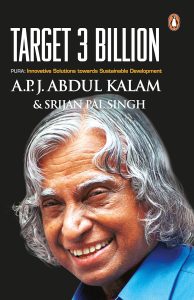Book summary by Mr. Viraj Rane, Research Associate, EECC
Target 3 Billion: PURA – Innovative Solutions towards Sustainable Development, by Dr. A.P.J. Abdul Kalam and Srijan Pal Singh, is a thoughtful and inspiring book that provides a clear vision for addressing rural development challenges around the world, especially in India. The title refers to the nearly 3 billion people who live in rural areas, many of whom face poverty, lack of infrastructure, and limited opportunities. The book introduces the concept of PURA, which stands for Provision of Urban Amenities to Rural Areas.
Dr. A.P.J. Abdul Kalam was a distinguished Indian scientist and the 11th President of India. Known for his contribution to the field of space science, he has authored numerous books and inspired youths with a vision for India. He was awarded the Bharat Ratna, Padma Bhushan and Padma Vibhushan. Srijan Pal Singh is an electrical engineer (IET, Lucknow) and an MBA graduate from IIM Ahmedabad. He worked closely with Dr. Kalam on various rural development projects, including PURA, and has co-authored several books with him. Mr. Singh is CEO and founder of non-profit organisation Kalam Centre.
The Core Idea: The PURA Model
At the heart of this book is the PURA model, an initiative that was close to Dr. Kalam’s heart during his tenure as the President of India. PURA aims to provide rural populations with access to physical, electronic, and knowledge infrastructure to promote economic growth and development. The authors emphasise that development should not be restricted to urban areas; instead, rural regions should be given equal importance in terms of infrastructure, education, healthcare, and employment opportunities.
PURA envisions transforming rural areas into hubs of economic activity, where people can thrive without migrating to cities. By integrating urban amenities in rural regions, such as modern transportation systems, clean energy, digital connectivity, and access to quality education and healthcare, the PURA model seeks to create self-sustaining communities that can manage their own development. This approach ensures rural areas are not left behind in the quest for national growth.
Key Components of PURA
Physical Connectivity: This involves building reliable infrastructure such as roads, transportation, water supply, and electricity. By improving connectivity, rural areas can link to markets and services, stimulating economic activity.
Electronic Connectivity: Digital infrastructure, including internet access and telecommunications, is crucial for linking rural populations to the world. This facilitates better education, healthcare, and access to information, which empowers communities to innovate and grow.
Knowledge Connectivity: Education and vocational training are key to the PURA model’s success. It involves providing rural populations with the skills to compete in today’s world. Whether it is technical knowledge, agricultural best practices, or entrepreneurial skills, knowledge empowers individuals to lift themselves out of poverty.
Economic Connectivity: This involves creating job opportunities and fostering entrepreneurship. The authors advocate for developing micro-enterprises and small-scale industries within rural communities, allowing people to sustain their livelihoods locally.
Sustainability and the Environment
A strong emphasis of the book is on sustainability. The authors believe that development should not come at the cost of the environment. Therefore, they suggest using renewable energy such as solar and biogas to power rural areas. They also highlight the importance of water conservation and sustainable agriculture. Environment friendly rural development can be beneficial for future generations.
Community Participation and Empowerment
A key message of the book is the importance of community involvement in the development process. The authors believe that rural people should be active participants in shaping their future. This means engaging local communities in decision-making and encouraging them to take ownership of projects that improve their lives.
Public-private partnerships (PPP) are another essential element of the PURA model. The book explains how collaboration between the government, private companies, and local communities can ensure development initiatives are successful and reach the people who need them.
Global Relevance
Although the book focuses on India, its ideas are relevant to rural communities globally. The authors believe that the PURA model can be adapted and applied in different regions to address issues of poverty, lack of infrastructure, and limited access to education and healthcare, and bring about sustainable development.
A Call to Action
The book is a call to action. Dr. Kalam and Srijan Pal Singh encourage young people, entrepreneurs, policymakers, and citizens to take an active role in promoting rural development. They inspire readers to think beyond cities and focus on the potential of rural areas, where billions of people live. By providing opportunities and creating a supportive environment, rural populations can thrive and contribute to national growth.
Target 3 Billion is an inspiring and optimistic book that provides a clear roadmap for rural development. Through the PURA model, the authors offer a solution that integrates modern infrastructure, technology, education, and sustainability into rural communities. The book’s message is simple yet powerful: rural areas should not be left behind in the development process, and by empowering these communities, we can create a better future for millions of people.


